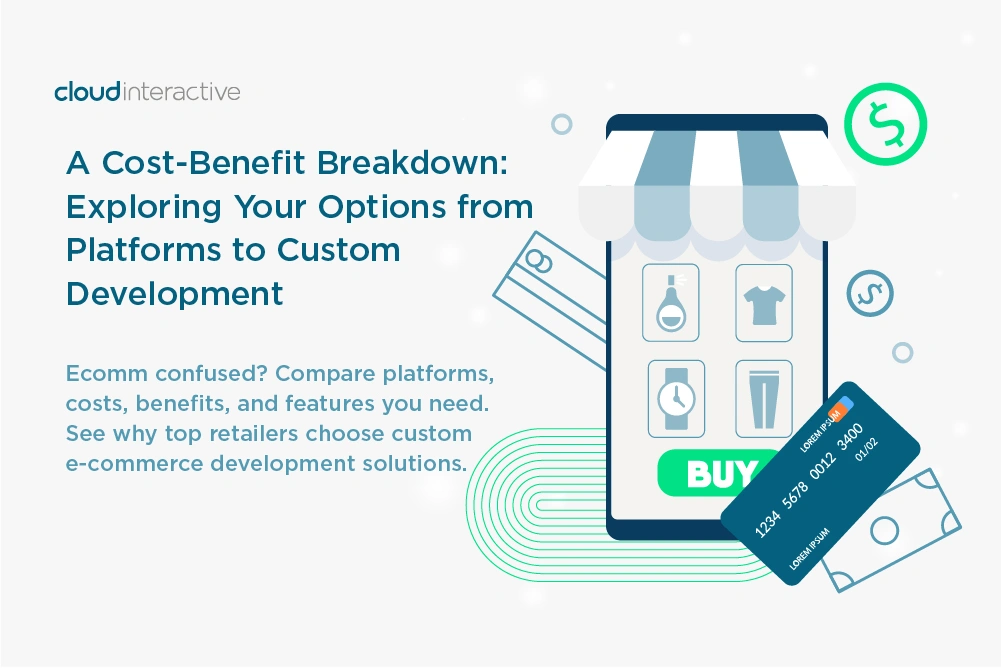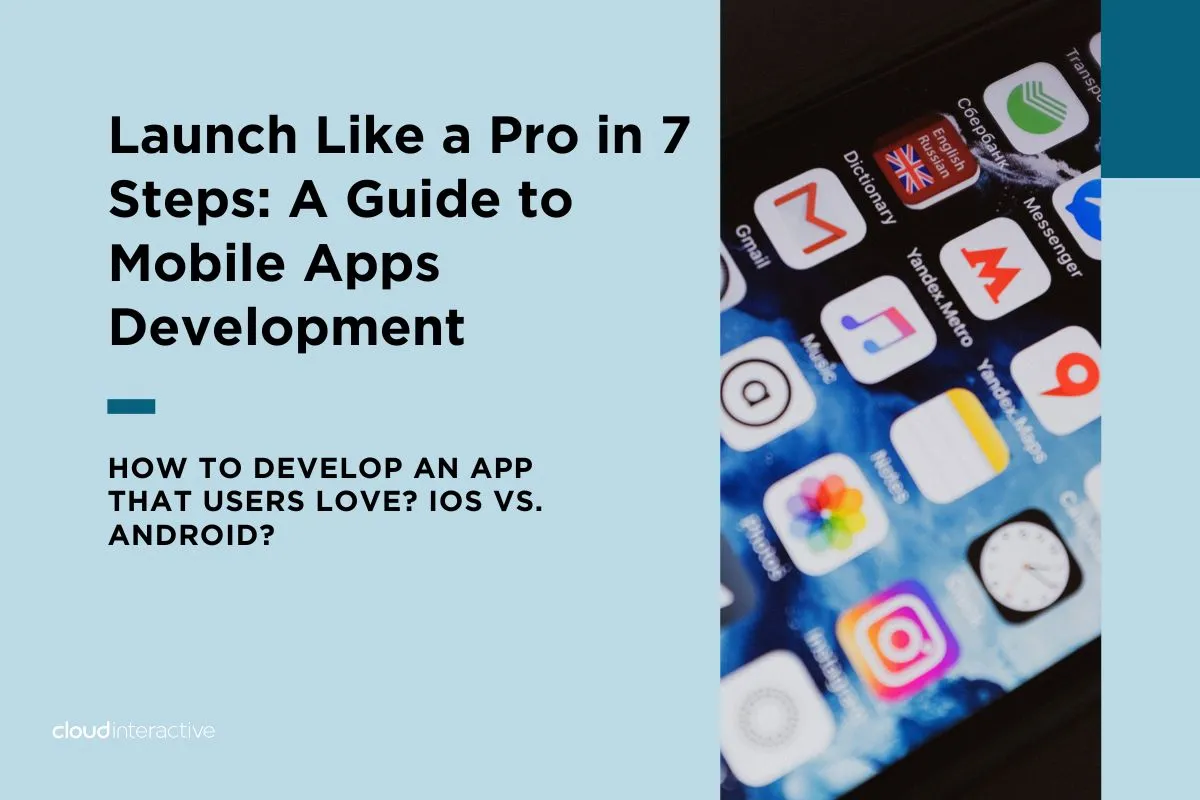
Launch Like a Pro in 7 Steps: A Guide to Mobile Apps Development
We’re inseparable from our phones; there’s no getting around it. Each of us has our own customized suite of mobile applications catered to our daily needs on regular rotation. Savvy businesses understand this implication and are busy developing in-house apps to gather first-hand data on their user base and deliver precise advertisements to customers. Every developer naturally wants to ensure their app stands out, but only the dedicated ones perform any market analysis to confirm if there’s even a need for such an app. However, these efforts are undoubtedly worth it. Consider the astounding success of apps like Instagram and Uber, which have revolutionized their respective industries through innovative app development strategies. Putting the digital legwork in and researching your app’s market potential can pay dividends when performed correctly.
In this blog, we’ll delve into the key considerations, tools, and best practices for developing a successful mobile application for your business. Whether you’re Android-for-life or iOS Nation, the characteristics of quality app design should be universally applied. By the end of this article, you’ll have a solid idea of how to craft the right app for your business’s needs (and which parties to trust with designing it). So, let’s get into it!
What is mobile app development?
Let’s start with the basics. Mobile app development is creating software applications that run on mobile devices, such as iOS or Android platforms. These apps involve a mix of coding, design, and user experience considerations during the design process.
The development cycle normally includes planning, designing the user interface, writing code, testing for bugs, and finally deploying your app. Ultimately, you want to create user-friendly and functional apps that enhance the user experience and meet specific needs or solve problems. The first stage in the mobile app development is market research.
Key Points of App Market Research
Market research is a crucial step in any app development process. It equips your business with a strategic advantage by gathering current market information and understanding your user needs and preferences. Properly analyzed, this assortment of data can steer product development and market positioning in the right direction, giving your product or service a distinct and attractive edge to your users.
Okay, so now that we agree that app research is worthwhile, where do we begin? To conduct the best quality app market research you can, focus on these three key points:
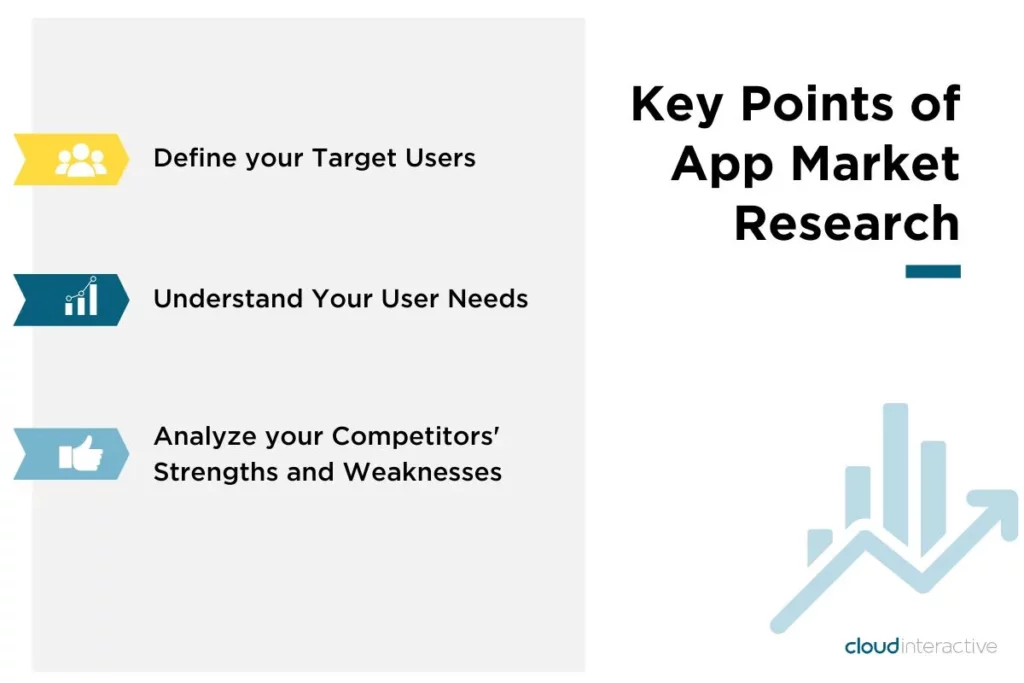
Define your Target Users
Before you start developing your app, identify your target users. These individuals are the ideal users for your application. Defining their user personas includes gathering information such as their gender, age, nationality, occupation, interests, and education level.
Designing your app from the users’ perspective forms the bedrock of your app development strategy, showing them that their needs and preferences matter to you. Ideally, you want your app’s flow and features to align with your users’ habits to increase user engagement in the long run. Repeat users are the gold standard for any marketing campaign.
Adopting a user-centric approach when developing your app is critical. Let’s say, for example, that a ‘global fast-fashion women’s clothing brand’ wants to create an app. Who are their target users? Well, they might start by targeting women aged 15-39 who follow fashion trends and frequently purchase the latest styles. Designing an app from the users’ perspective in this manner means that you’re giving them incentives to actively engage with your content since it’s already aligned with their interests.
Understand Your User Needs
Once you’ve defined your target users and their characteristics, the next step is understanding their unique needs. This step involves understanding when and why these users will engage with your app and what features they expect. No two users are ever the same, but incorporating these features definitely enhances user interaction and engagement with your app.
As such, incorporating a product review section in your application is a tried-and-tested means of reassuring your users about their shopping experience.
Analyze your Competitors’ Strengths and Weaknesses
Pay attention to the features your competitors offer, learn from their strengths, and, more importantly, identify weaknesses in their apps that you can refine for your own needs. User reviews on app stores are invaluable for insights into these areas for improvement.
What Tools Are Available for App Development? Can I Develop an App Myself?
It depends! If you’re comfortable with coding and understand app development concepts well, you can build an app yourself using the tools mentioned above. There are plenty of online tutorials and resources to help you get started.
The two leading mobile operating systems are Android and iOS, each built on a specific programming language. Decide which platform you plan to target first to determine the development tools and languages you’ll need.
- iOS App Development: Apple uses Objective-C and Swift, with the company’s Xcode as the primary development tool.
- Android App Development: Android developers employ Java and Kotlin, with Google’s Android as the main component.
Which App Platform to Develop First?
Due to varying user preferences for operating systems, many apps are developed simultaneously for iOS and Android. The decision on which platform for your app development first will depend on your user demographics (the ones you researched, remember?), development goals, costs, and monetization plans.
Key Differences:
- Android: An open-source platform with a high global market share (over 70% as of early 2024). Suitable for reaching a broad audience. Android Apps are immensely flexible and can be developed on any computer.
- iOS: While its global market share is lower, Apple has had greater success in bringing its users up to date, with over 66 percent of users having iOS 17 installed, compared to just 13 percent of Android users running the latest version. iOS is limited to particular devices, saving testing time and ensuring stability. It also offers higher security for both software and user information, though with less developer flexibility.
Cross-Platform App Development
Is It Hard to Make An App? What Resources Are Available for me to learn app development?
To learn how to develop an app from scratch, you must understand the roles that database integration, API integration, SDK usage, and UI/UX design play in the development process.
Google Search
Search for “app development learning” to find the top-ranking articles covering the different programming languages and basic logic. Forums like Discord, Quora, and Reddit have dedicated communities focused on asking and answering questions about development and sharing experiences.
YouTube Tutorials
Video tutorials offer a visual and auditory learning experience, showing the development process and highlighting potential issues and details to consider. The volume of content released on an ongoing basis is immense, and tutorials on how to make an app are available at all levels.
Online Courses
Platforms like Codecademy and Coursera are filled with user-friendly app development courses that provide structured teaching outlines and learning objectives, making systematic learning efforts as straightforward as possible.
By utilizing the resources above, you can build a solid foundation in app development and gradually develop the expertise necessary to create a fully functional and appealing app. Remember, these resources are here to support your learning journey and give you the confidence and capability to develop your own apps.
10 Key Considerations for High-Quality App Development
Simply put, making an app isn’t hard. But to make a high-quality and successful app for your business, consider these five key points during development or optimization:
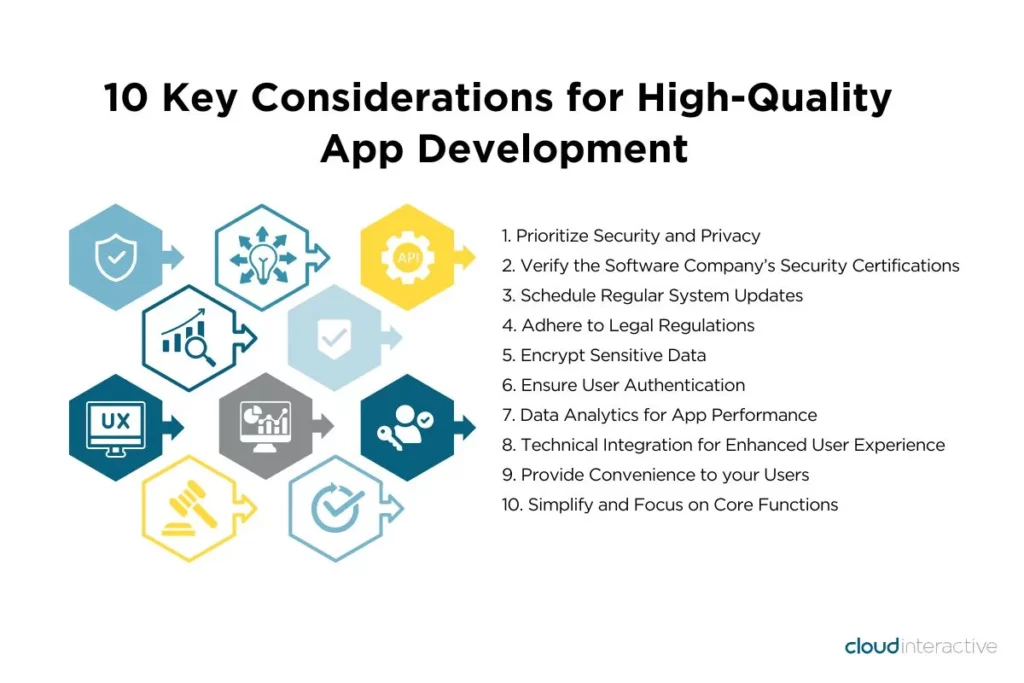
1. Prioritize Security and Privacy
2. Verify the Software Company’s Security Certifications
Only collaborate with software companies that have verifiable security certifications. This helps safeguard information, assess risks, and provide solutions to potential threats, minimizing your losses in emergencies.
3. Schedule Regular System Updates
Provide regular updates for your systems, software, and general hardware to counter nefarious hacking attempts, reducing your risk of exposure.
4. Adhere to Legal Regulations
Any aspiring app developer should be familiar with various development regulations, including basic security standards, user consent for data collection, compliance with public decency, and respect for intellectual property rights. For example, app developers in the US must follow the California Consumer Privacy Act (CCPA) and the Health Insurance Portability and Accountability Act (HIPAA) if their intended app handles medical data.
5. Encrypt Sensitive Data
Encrypting sensitive data during transmission or storage can minimize losses in case of data breaches.
6. Ensure User Authentication and Authorization Mechanisms
Implement Multi-Factor Authentication (MFA) to enhance user security. MFA adds a layer of security by combining two or more different factors, including passwords, security questions, fingerprint scans, and phone verifications, to prevent identity theft.
7. Data Analytics for App Performance
After launching your app, collecting and analyzing performance data is critical. Incorporating a backend that consolidates marketing-related data can help assess your app’s successes and generate insights into its development needs.
Key metrics to monitor include:
- The number of active daily and monthly users
- Peak usage times for practical promotional activities
- Page views, clicks, and time spent on each page
Embedding data tracking instructions during your initial app planning phase facilitates better internal analysis and more informed decision-making for future updates.
8. Technical Integration for Enhanced User Experience
An example of API use in action is a retail brand membership app that uses Twilio APIs to integrate their application software with WhatsApp. Twilios Conversations API lets you start with a channel like a web or in-app chat and expand to other channels as consumer preferences evolve. Meanwhile, the app integrates with POS so customers can use app vouchers for store discounts.
9. Provide Convenience to your Users
Enhancing user convenience can significantly improve your app’s adoption and satisfaction ratings. Take the two features below as an example:
- Quick Social Media Logins: Allow your users to sign in using their social media accounts (Google, Facebook, Instagram, etc.) to save time and avoid tedious registration processes.
- Mobile Payment Options: Incorporate mobile payment methods to simplify the checkout process, enabling quick and easy transactions.
10. Simplify and Focus on Core Functions
While including an exhaustive set of features may be tempting, an overloaded app can reduce usability and frustrate users. Focus on delivering the core functions first and develop supplementary features that enhance these primary services.
Instead of cramming every possible function into an app, center the design around the essential features that provide the most value to your users, making the app as intuitive and easy to navigate as possible.
Additional Reading: App Development Case Study – TECO
Following these considerations, you can build a top-quality app that meets your users’ needs, ensures security, and provides a smooth and enjoyable experience.
How to develop an app?
Once you have a preliminary concept for app development and have completed your market analysis, it’s time to move into the formal development phase. It consists of the following seven main steps, covering everything from development to promotion and maintenance after launch. These steps are outlined below:
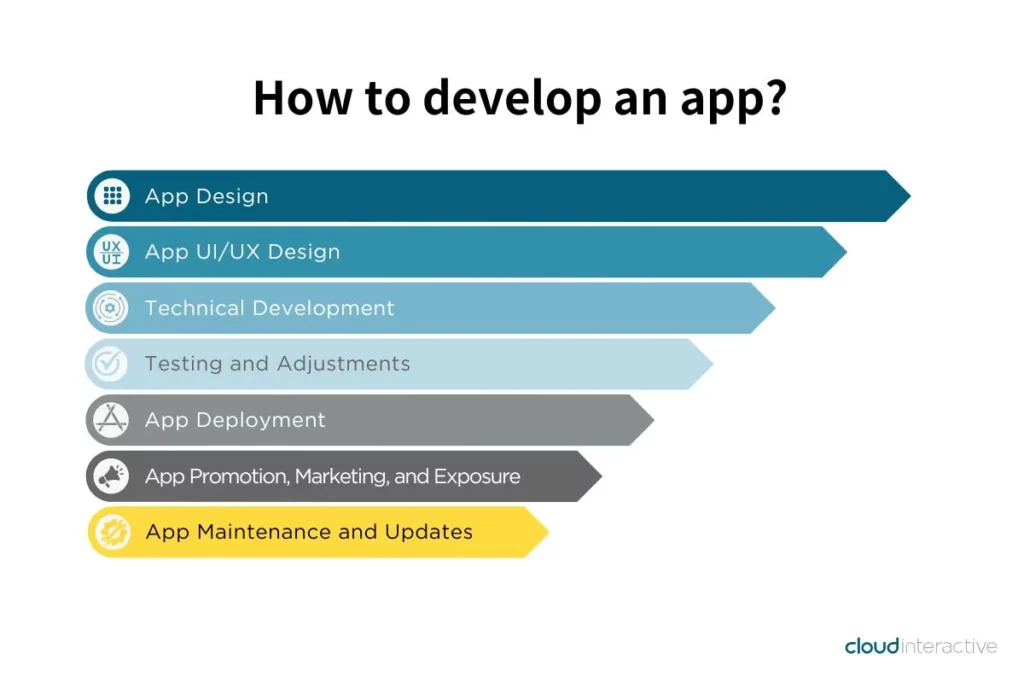
Step 1: App Design
Based on the user needs and objectives you identified during market research, brainstorm the app’s core features.
Ask yourself: How can these features be interconnected for smooth operation and user-friendliness? In the design phase, you can explore all possibilities and gradually zero in on the core essential elements that define your intended user experience.
Step 2: App UI/UX Design
UI (User Interface) design focuses on the app’s interface’s aesthetic appeal and intuitive operation. It includes aspects like branding consistency, font readability, and color schemes.
UX (User Experience) design, on the other hand, emphasizes how your users interact with your app. It considers factors such as ease of finding features, adherence to user habits, and minimizing the time and effort required to accomplish tasks.
Step 3: Technical Development
Once the app’s design and concept are finalized, the development phase begins. This stage involves programming the app, integrating databases, setting up servers, and various technical tasks.
Regular communication within your team is critical throughout development to ensure an aligned vision between the desired app and the actual product.
Step 4: Testing and Adjustments
After completing the development, your app should undergo testing by internal and external testers. These testers assess the app’s performance under various scenarios to identify any anomalies or malfunctions.
They also evaluate the simplicity and logic of the interface and user experience. This iterative testing and adjustment process helps uncover and address issues before the app officially launches.
Step 5: App Deployment
Once your newly minted app is ready to roll, it can be deployed to relevant app platforms for users to download or purchase. Each platform has its submission fees and review processes, which may require multiple rounds of review before the app goes live. Allocating sufficient time for the review process is essential to avoid any troublesome delays in your app’s launch.
- Apple App Store Submission Guidelines: Annual fee of $99, review time approximately 1-2 weeks.
- Google Play Store Submission Guidelines: One-time fee of $25, review time approximately 1-2 days.
Step 6: App Promotion, Marketing, and Exposure
Even if you can boast of having the best app in the world, attracting anyone to use it is going to be challenging without proper promotion. Consider using external channels such as YouTube, Facebook, and Instagram and optimizing App Store Optimization (ASO) to improve your search rankings.
ASO involves adjusting an app’s name, description, keywords, and visuals to influence its search ranking in app stores. The higher your search rankings, the more likely you are to gain potential customers.
Step 7: App Maintenance and Updates
Collecting user feedback is hugely important for future optimization. Regular updates maintain a stable ASO ranking and so enhance your app’s security and privacy. Even without adding new features, you should prioritize app maintenance and updates to keep your app current and secure. The last thing you want is for your users to jump ship because a competitor offers an app with improved stability.
Following these steps can help ensure your app’s successful development, deployment, and maintenance, creating a satisfying user experience and increasing overall app engagement.
Contact Us
Let our app development expertise bring your idea to life. Request a free quote today! Tap below to get in touch.
How much does App Development Cost? The Factors Influencing Development Prices
The Complexity of The App’s Functionalities
The complexity of your app’s features directly impacts development time and, consequently, labor costs. When asking, “How much does it cost to develop an app?”, it’s important to note that apps requiring integration with other systems and platforms or possessing complex functionalities typically command higher development costs.
- Low Difficulty: Apps that only provide product information without check-out functionalities.
- Medium Difficulty: Standard e-commerce apps with shopping cart functions, database integration, and payment gateways.
- High Difficulty: Integrate with live streaming platforms, diverse promotions for distributor levels, some involving AI image search, and more.
Labor Costs of App Development
A standard app development project normally involves at least one interface designer and one app developer. However, creating a fully functional app that meets your user needs and enhances business performance might necessitate a full development team.
A typical app development team includes:
- Project Manager: Manages development schedules and communication between stakeholders.
- UI/UX Designers: Plan interfaces to align with client expectations and user needs.
- iOS/Android Developers: Depending on the target platforms, both types of developers may be required.
- Backend Developers: Ensure app stability and smooth operation.
- App Testers: Conduct thorough testing to identify and rectify issues post-development.
Other App Development Costs
- App Submission Fees: As mentioned previously, submitting an app to various hosting platforms incurs costs. These costs must be factored into your development budget.
- Maintenance Costs: Whether self-maintained or outsourced, regular maintenance expenses are necessary. These may include personnel costs for maintenance staff or fees paid to software development companies for maintenance services.
Estimating App Development Costs across Three Approaches
In-House Development
Hiring specialized personnel internally will incur costs based on their respective salaries. Developing a moderately complex app takes an average of six months.
Assuming one employee for each of the five key positions (1 developer for each platform, 1 UI/UX designer, 1 backend developer, 1 project manager, and 1 QA tester) with an average monthly salary ranging from $85,000 to $135,000 (USD), the total labor cost for app development ranges from $510,000 to $810,000.
Outsourcing to Individual Studios
Many small studios offer app development services, with costs typically falling below $6,000 USD in Taiwan. However, these studios may be limited in handling complex app requirements involving enterprise-level system integrations and cloud services.
Professional App Development Companies
Consider outsourcing to professional software development companies for high-quality, user-attracting apps. In Taiwan, the costs typically range from $15,000 to even $250,000 (USD), depending on the complexity.
While this can represent a substantial investment for some businesses, app development companies provide a more reliable and efficient solution with their comprehensive range of services. These services include market research, design, and development teams.
App Development Company: Cloud Interactive Taiwan
- Health and Fitness
- E-commerce
- Mobile Banking
- Product Management
- Retail Membership CRM Platforms
- Internal Enterprise Applications
Our strengths lie in several key areas:
- Competitive pricing: As a custom mobile app development company based in Taiwan, we leverage our local expertise to offer cost-effective solutions without compromising quality.
- Diverse Industry Experience: We’ve accumulated deep experience across industries such as retail, shipping, mining, manufacturing, healthcare, finance, and technology.
- Emphasis on Information Security: With some well-known global clients under our belt, we take pride in our commitment to information security.
- UI/UX Design Expertise: We emphasize user interaction experience at every step of the app development process, ensuring our products align closely with users’ needs and expectations.
- Tailored Solutions: We provide customized solutions tailored to each client’s specific challenges and requirements.
- Agile Development Approach: We employ flexible development methodologies suited to each project’s progress and individual requirements, enabling more efficient communication and collaboration throughout the development process.
At Cloud Interactive, we are committed to delivering high-quality app solutions that meet and exceed your expectations.
Success Case Study|Revolutionizing Retail with Carrefour Taiwan
We helped Carrefour Taiwan consolidate its apps into one innovative platform. This all-encompassing app introduced groundbreaking features such as online shopping, in-store sales, app-exclusive promotions, member rewards, and digital wallet services. Our collaboration with Carrefour Taiwan in the fiercely competitive retail landscape empowered the company to launch this game-changer app that led the industry. By integrating Carrefour’s interfaces and functionalities into one platform, we not only streamlined its services but also liberated its users from juggling multiple apps. The result? A significant boost in app downloads, user engagement, and overall customer satisfaction.
Success Case Study|Elevating Customer Loyalty with a Membership App for a Renowned Restaurant Group Chain
Within just one year of its launch, the app attracted over a million members, offering features such as online reservations, mobile payments, loyalty point accumulation, and reward and coupon redemption. By streamlining information from the 20-plus different brands under the restaurant chain’s banner, the app became a unified platform for managing customer data. This enabled the client to identify and nurture loyalty among its members while targeting new customers through customized promotional campaigns tailored to different customer segments.
By Cloud Interactive
Meet the masterminds behind the curtain at Cloud Interactive. We're not just software developers - we're also a content crew fuelled by caffeine and a thirst for knowledge. We translate tech jargon into plain English, dissect industry trends, and craft helpful tips that are informative and engaging. So, buckle up and join us on a journey through the ever-evolving and exciting world of technology!

